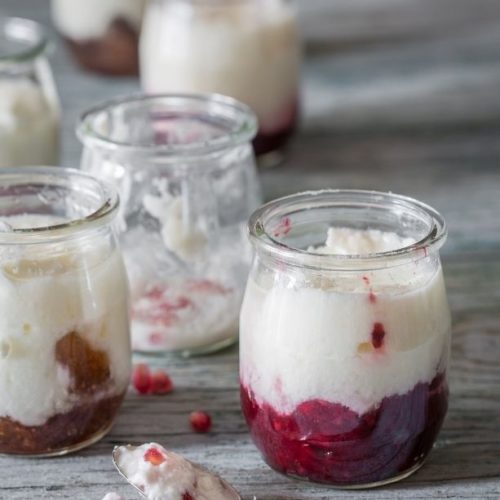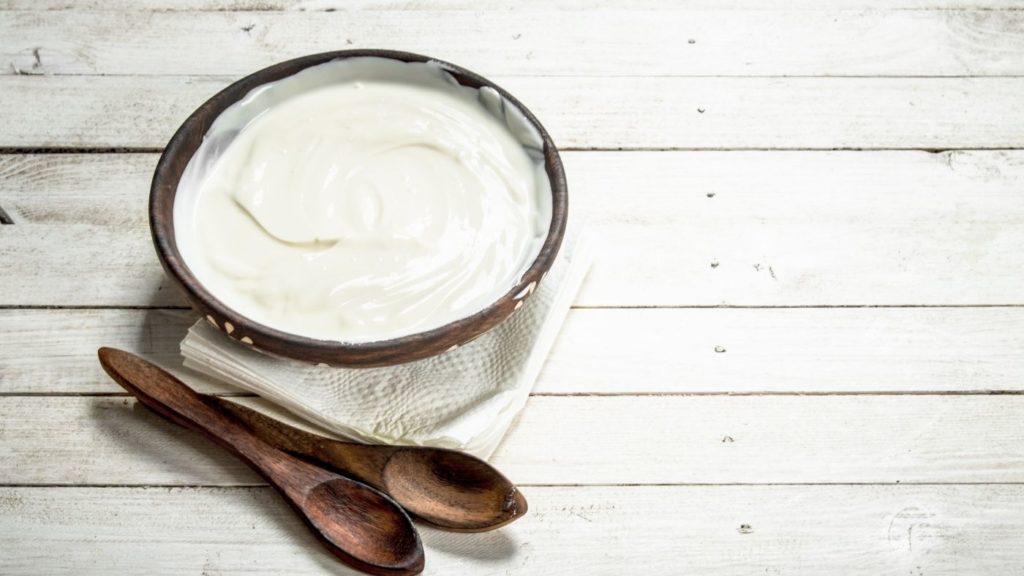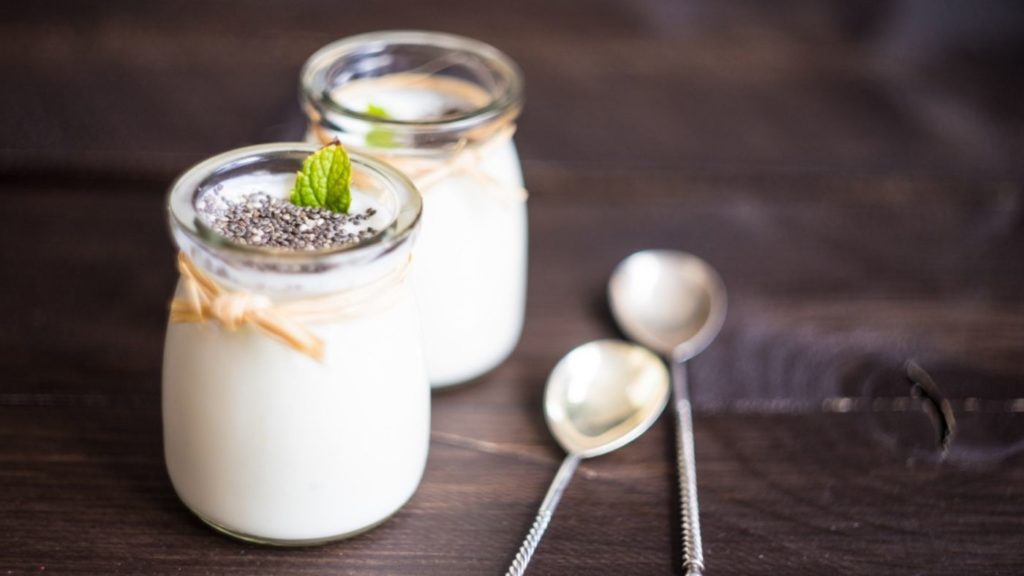Making yogurt at home is easy! With or without a yogurt maker, you can make a creamy and delicious yogurt, to be flavoured according to your taste.
This complete guide will teach you everything you need to know to succeed in making yogurt every time!
How to Make Yogurt
- Heat the milk
- Allow cooling
- Add powdered starter culture or yogurt
- Allow incubating in a warm place for a few hours
- Refrigerate and enjoy!

Summary

Homemade Yogurt Recipe
Equipment
- Saucepan
- Cooking thermometer
- Wooden spoon
- To ferment the yogurt, it is very important to keep it warm, i.e. around 42°C (108°F). There are several ways to do this using:
- A yogurt maker
- An oven turned off with light on
- A pressure cooker in "yogurt" mode
- A cooler filled with hot water bottles
- To learn more about these different options, see how to make yogurt without a yogurt maker.
Ingredients
- 2 L milk
- 10 g yogurt culture (or 2 tablespoons of homemade or commercial yogurt)
- ½ cup powdered milk (for thicker yogurt) (or 1 pouch of gelatin (7g))
Steps
Milk Preparation
- Pour the milk into the saucepan. If desired, add the powdered milk and mix thoroughly.
- Gently heat the milk to 82°/180ºF, or until it boils. Stir from time to time with the wooden spoon to prevent the milk from sticking to the base of the saucepan.
- When the milk reaches 82°C/180°F, remove it from heat and let it cool down to 42-44°C/108-112°F. To speed up the process, plunge the saucepan into a sink filled with ice water.
- As an option with gelatin: dissolve the gelatin pouch with a little milk in a small bowl, allow it to swell (rise, puff up) and then blend in with the rest of the mixture.
Yogurt Fermentation
- Add the starter culture or yogurt to a small amount of warm milk and mix well.
- Add to remaining milk. Stir well to distribute the culture in the milk.
- Pour the inoculated milk into one or more containers. Close, and place in the yogurt maker or incubator of your choice (oven turned off, pressure cooker, cooler, etc.).
- Let it incubate for 4 to 8 hours. Fermentation speed varies according to temperature and incubation method. The longer the incubation, the firmer and sour the yogurt will be.
Rest And Flavouring
- Remove the yogurt from the incubator and let it cool down on the counter for an hour.
- Place in the fridge for 8 hours, or overnight. Yogurt will thicken as it cools.
- Save a few tablespoons of this yogurt for your next recipe.
- Flavour to your taste and enjoy!
- Optional: for Greek yogurt or labneh, drain the yogurt in a Kefirko Cheese Maker or cotton bag overnight.
- Yogurt will keep in the fridge for about two weeks.
Notes


How to Flavour Your Yogurt?
There are many ways to flavour your homemade yogurt! However, we recommend waiting until after the fermentation before adding the desired flavours.
This way, the added ingredients won’t interfere with the fermentation.
Sweet Flavour Ideas
The advantage of flavouring your homemade yogurt is that you control the quality and quantity of sugar. Farewell to additives and preservatives, and welcome to natural and delicious yogurt!
You can add:
- Honey, berries, and granola
- Jam or marmalade
- Maple syrup and walnuts
- Sweetened condensed milk and vanilla
- Berry shrub

Ideas for Savoury Flavours
While less consumed than their sweet versions, savoury yogurts are nonetheless delicious! They are perfect as a snack, or as a sauce to accompany a meal.
Why don’t you try:
- Dried tomatoes, pesto, and a drizzle of olive oil
- Mint, cucumber, and garlic (as in our kefir tzatziki recipe)
- Labneh with za’atar
- Just a pinch of salt and pepper!
Frequently Asked Questions (FAQ)
- At What Temperature Should I Incubate My Yogurt?
- How to Make Yogurt Without a Yogurt Maker?
- Why Is My Yogurt Liquid?
- Why Is My Yogurt Sour?
- How Can I Get a Thicker, Creamier Yogurt?
- Why Is My Yogurt Grainy?
- What Kind of Milk Do I Use for My Yogurt?
- Can I Make Yogurt With Plant-based Milk?
At What Temperature Should I Incubate My Yogurt?
Conventional yogurt culture is made of good bacteria called “thermophilic” bacteria. This means that they need gentle and constant heat to do their job.
The target temperature for fermentation is between 40 and 45°C. If the temperature is lower, the yogurt will not ferment. If it is higher, the heat will kill the good bacteria in the yogurt. The ideal temperature for making yogurt is 42°C.
There are yogurt makers on the market that keep the yogurt at a constant temperature. Some pressure cookers also have pre-programmed “yogurt” functions.
How to Make Yogurt Without a Yogurt Maker?
You don’t have a yogurt maker? Place jars in your oven with the oven turned off but keep the oven light on to create a low source of heat. Monitor the temperature during fermentation: if necessary, open the oven door, or place a bowl of boiling water in the oven.
For more ideas, check out our article on how to make homemade yogurt without a yogurt maker.
You don’t want to worry about keeping your yogurt wrapped up? Consider using viili or matsoni cultures.
These “mesophilic” cultures don’t need a yogurt maker or heat to ferment. You’ll be making your yogurt at room temperature, on the counter! To learn more about it, read our article on mesophilic yogurt.
Why Is My Yogurt Liquid?
Yogurt can be liquid if it was not heated up to 82°C before the inoculation. Indeed, heating the milk will modify the milk proteins to allow the yogurt to become creamier and thicker.
Liquid yogurt can also come from a weak culture. If you backslop your yogurt with the same culture over several recipes, it may have weakened. Test with a new strain.

How Can I Get a Thicker, Creamier Yogurt?
To get a thicker yogurt, use whole milk, or replace some milk with cream. You can also add powdered milk or gelatin before heating the milk.
If your yogurt hasn’t set, don’t be discouraged! You can let it drain in a cotton bag to remove some of the whey. This is also how you get Greek yogurt or labneh!
Why Is My Yogurt Sour?
If your yogurt tastes very sour or has split into two parts (one white and the other translucent), don’t panic!
The most common cause is a fermentation that took too long or at too high a temperature. Bacteria have created an excess of lactic acid, which explains its sour taste.
Too much acidity can even cause the milk to curdle and separate it into two distinct layers: curd and whey. Simply mix the two layers with a whisk or immersion blender. If you want to mask the sour taste, just add a little more maple syrup!
Sour yogurt may be the result of weak yogurt culture. If you’ve used a commercial yogurt, try another brand, or switch to powdered starter cultures.
Why Is My Yogurt Grainy?
Yogurt texture can be affected if the milk is heated too quickly. A temperature that rises too quickly can alter the milk proteins. Milk proteins will clump together instead of forming a thick yogurt, creating small, unpleasant pieces of curd.
To deal with this problem, strain the yogurt through a blender or sieve.
What Kind of Milk Do I Use for My Yogurt?
The milk used will influence the taste and texture of the yogurt.
Pasteurized cow’s milk is the most common choice. The higher the milk fat content, the creamier the yogurt will be.
Lactose-free milk can work and give good results. However, the firmness of yogurt may vary depending on the brand of milk used.
Sheep’s milk and goat’s milk have different compositions to cow’s milk. Goat’s milk makes a more liquid yogurt, while sheep’s milk produces a firmer yogurt than cow’s milk. It also requires a shorter heating time.
Can I Make Yogurt With Plant-based Milk?
It is possible to make vegan yogurt with plant milk. However, depending on the milk used and its composition, results may vary. Here are a few tips for making successful vegetarian yogurts.
- Choose a soy beverage or plain coconut milk. These kinds of milk will provide the creamiest results due to their high protein content.
- Replace powdered milk with soy milk powder. This will give some texture to the yogurt.
- Use agar instead of gelatin for a vegan alternative.
- Add cashews that have been soaked overnight in plant milk and reduced into a liquid in a blender. Nuts add creaminess to the yogurt.
- If the yogurt is very liquid, drain it in a cheesecloth or cloth bag.
Take a look at our vegan yogurt culture and our vegan yogurt instructions.


